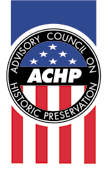 About ACHP
About ACHP ACHP News
National Historic
Preservation
Program
Working with
Section 106
Federal, State, & Tribal Programs
Training & Education
Publications
Search
Home
ADVISORY COUNCIL ON HISTORIC PRESERVATION PRESENTS PRESERVE AMERICA COMMUNITY DESIGNATIONS TO SALT LAKE CITY AND BRIGHAM CITY DURING SPRING BUSINESS MEETING
SALT LAKE CITY -- Brigham City and Salt Lake City were designated among the Nation’s newest Preserve America Communities at today’s business meeting of the Advisory Council on Historic Preservation (ACHP).
ACHP Chairman John L. Nau, III, and National Park Service Director Fran Mainella presented the certificates of designation, signed by Mrs. Laura Bush, First Lady of the United States and Honorary Chair of Preserve America, to representatives of the two cities.
“Sustainable historic preservation is not a cost for maintaining the past but a wise economic investment in the future,” said Nau. “Salt Lake City and Brigham City are among the recognized national communities that are creating more vibrant cities by retaining what is best from their heritage, and sharing the important cultural, educational, aesthetic, and monetary benefits of preservation with residents and visitors.”
With these two new designations, Utah now has 11 Preserve America Communities. Other designated Preserve America Communities in the State include Centerville, Farmington, Kanab, Manti City, Mount Pleasant, Murray, Payson, Pleasant Grove, and Tooele County.
While both Utah cities have extensive heritage tourism and other efforts to preserve and highlight their natural and cultural heritage resources, the following brief descriptions note some of the features that led to the Preserve America Community designations.
Brigham City, population 18,400, is located at the west end of Box Elder Canyon north of Salt Lake City.
Mormon pioneer William Davis first explored the area in 1850. Brigham Young directed Lorenzo Snow to create a self-sufficient city there in 1853, which became known as Box Elder. Young gave his last public sermon there in 1877 and the town subsequently was renamed in his memory. During World War II, Bushnell General Hospital was created to treat wounded soldiers. After the war through 1984, the hospital’s buildings housed the Intermountain Indian School. Some remaining buildings have been converted into businesses and housing. An annual Heritage Arts Festival is held in historic downtown Brigham City each year. The city also hosts “Peach Days,” the longest continuous harvest festival in Utah and the second oldest in the United States. Brigham City is the gateway to the Golden Spike National Historic Site, and participates in the Bear River Heritage Area, which promotes heritage tourism in three Utah and four Idaho counties.
Salt Lake City, population 182,000, is center to a larger metropolitan area. Before the Latter Day Saints arrived here and ended their famous exodus on July 24, 1847, the Shoshone, Ute, and Paiute had dwelled in the Salt Lake Valley for thousands of years. The Mormon Pioneers organized a new state called Deseret and unsuccessfully petitioned for its recognition in 1849. Great Salt Lake City replaced Fillmore as the territorial capital in 1858, and the name was subsequently abbreviated. It quickly became one of the most populous cities in the old west. It flourished through agriculture and mining, and in the early 1900s was the site of a major trolley line that used 144 cars. The trolley barn, rescued from demolition in the 1970s, is typical of the adaptive reuse that characterizes this dynamic city. The area including and surrounding Pioneer Park is further testimony to the revitalization taking place through public and private partnerships. A unique special heritage tourism draw attracting more than a half-million visitors per year is the renowned Family History Library, the largest genealogical library in the world.
Preserve America is a White House initiative that encourages and supports community efforts to preserve and enjoy the Nation’s priceless cultural and natural heritage. The goals of the initiative include a greater shared knowledge about the country’s past, strengthened regional identities and local pride, increased local participation in preserving the country’s cultural and natural heritage assets, and support for the economic vitality of communities. Detailed information on all aspects of this initiative can be found at www.PreserveAmerica.gov.
The meeting also included discussion of the current overall status of the Preserve America initiative and formative plans for a national Preserve America Summit this fall that will examine the current status of historic preservation in America, particularly in the wake of lessons learned due to Hurricane Katrina and Hurricane Rita, and will review the national historic preservation program in light of the fortieth anniversary of the National Historic Preservation Act of 1966.
Posted May 19, 2006